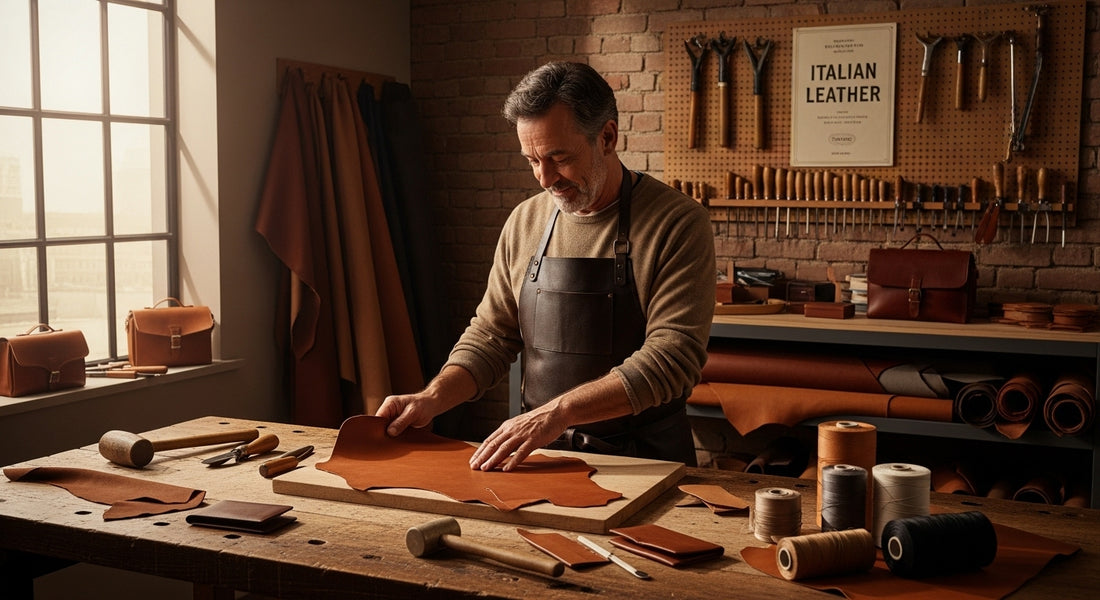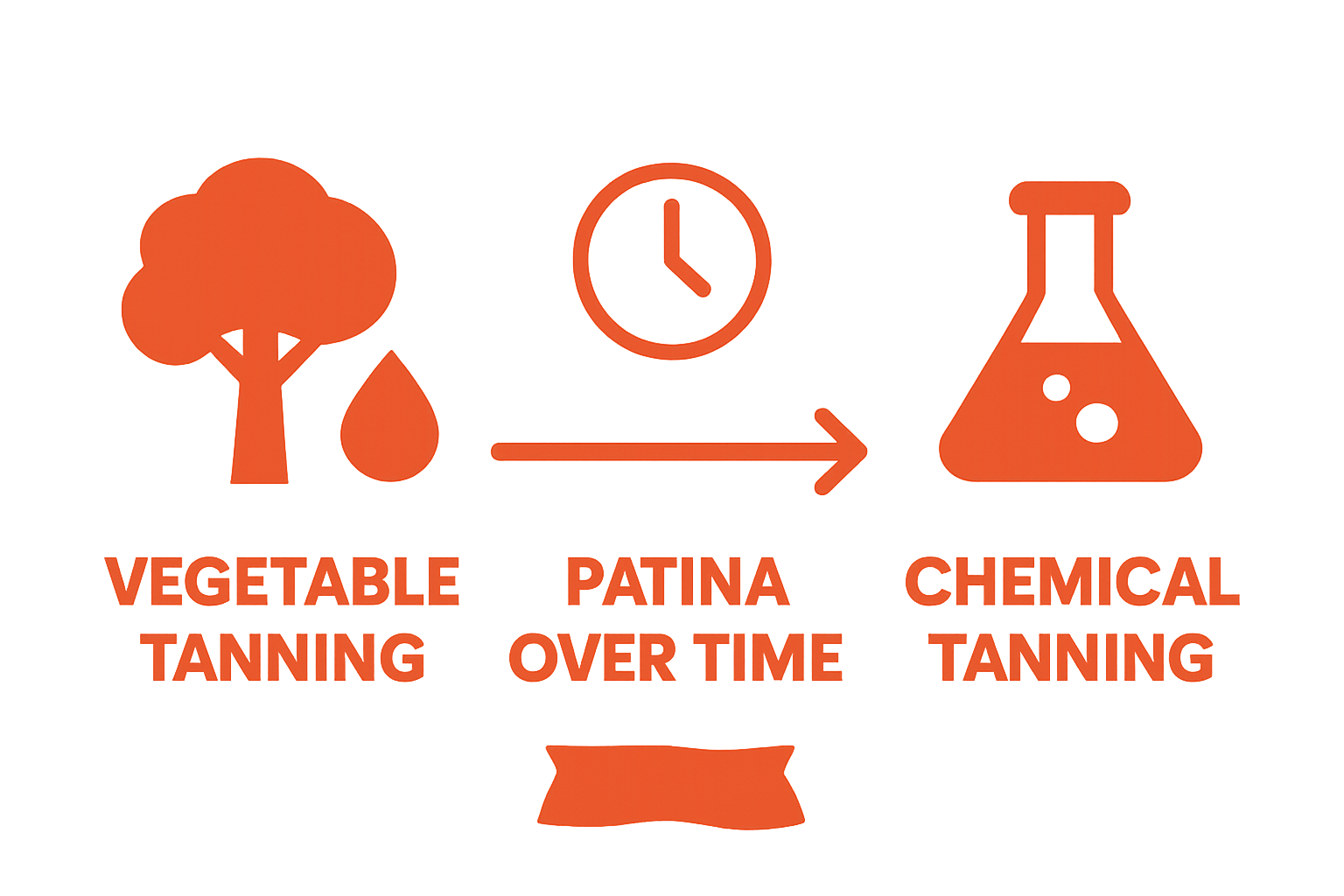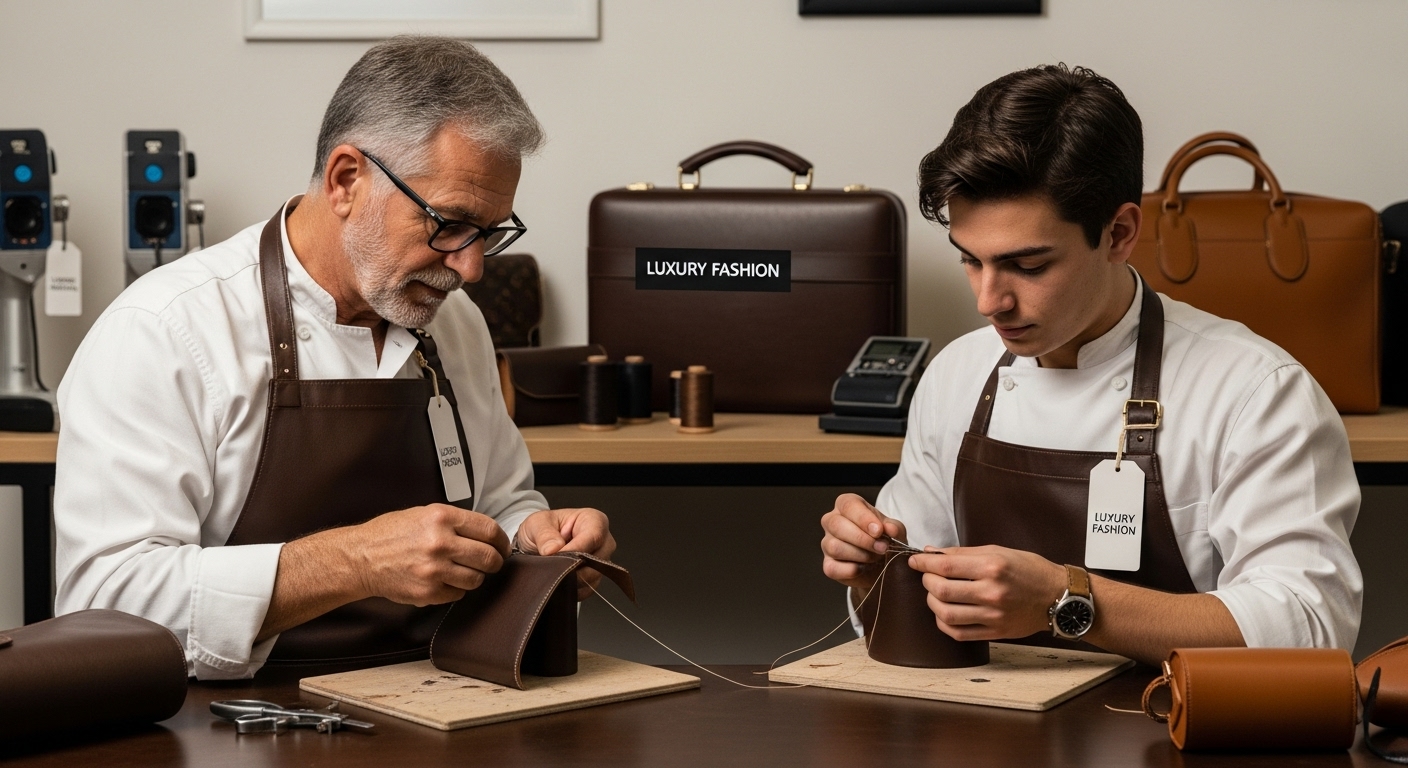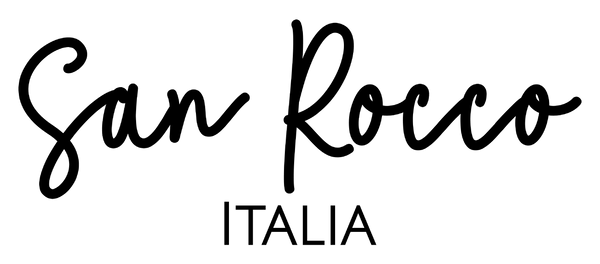
Understanding Italian Leather Craftsmanship: Timeless Quality
Share
Italian leather craftsmanship turns ordinary animal hides into sought-after treasures found in designer wardrobes and historic ateliers. Most people see a stylish bag and simply notice the label or the price, but the real story is written in the details. Less than 10 percent of all leather worldwide meets the exacting standards demanded by Italian artisans. That means every stitch, every tone of colour, and even the rich scent carries centuries of culture and ruthless attention to quality most have never experienced.
Table of Contents
- What Defines Italian Leather Craftsmanship?
- The Rich History Behind Italian Leather Production
- Key Techniques In Italian Leather Craftsmanship
- Why Italian Leather Matters In Luxury Fashion
- Sustainability And Ethical Practices In Italian Leather
Quick Summary
| Takeaway | Explanation |
|---|---|
| Italian leather prioritises quality materials. | Artisans select only the finest full-grain leather, ensuring unparalleled quality for their products. |
| Traditional techniques enhance craftsmanship. | Methods like vegetable tanning and hand stitching reflect a dedication to preserving heritage and skill in leather production. |
| Italian leather embodies sustainability. | The use of natural tanning processes and ethical practices underscores a commitment to environmentally friendly production. |
| Luxury fashion values Italian leather. | This leather serves as a symbol of prestige, communicating quality and craftsmanship in high-end products. |
| Innovation coexists with craftsmanship. | Modern technologies are integrated with traditional methods, enhancing quality control while respecting artisanal techniques. |
What Defines Italian Leather Craftsmanship?
Italian leather craftsmanship represents a profound cultural heritage blending centuries-old techniques with extraordinary artisanal skill. More than simply manufacturing leather goods, this tradition embodies a meticulous approach that transforms raw materials into extraordinary, enduring products.
The Art of Precision and Selection
At the heart of Italian leather craftsmanship lies an uncompromising commitment to material quality. Artisans select only the finest full-grain leather, carefully examining each hide for its unique characteristics. This rigorous selection process ensures that only superior leather meets their exacting standards. The future of Italian leather craftsmanship continues to be defined by this unwavering dedication to excellence.
Key characteristics of exceptional Italian leather include:
- Texture Integrity: Maintaining the natural grain and surface of the leather
- Colour Consistency: Achieving rich, even tones without artificial masking
- Durability: Creating leather products designed to improve with age
Traditional Techniques Meet Modern Innovation
Craftsmanship in Italian leather production is not static but a dynamic fusion of traditional methods and contemporary techniques. Skilled artisans employ techniques passed down through generations, such as vegetable tanning and hand stitching, while simultaneously integrating modern precision technologies. According to research exploring leather manufacturing processes, this balance between heritage and innovation distinguishes Italian leather craftsmanship on the global stage.
The result is not merely a product but a narrative of skill, passion, and cultural identity woven into every stitch and fold. Each piece represents a testament to Italy’s profound understanding of leather as both a material and an art form.
The Rich History Behind Italian Leather Production
Italian leather production represents a profound narrative of cultural evolution, technological innovation, and artisanal mastery that stretches back centuries. From medieval trade routes to contemporary global markets, the Italian leather industry has consistently distinguished itself through exceptional quality and innovative techniques.
Origins and Medieval Foundations
The roots of Italian leather craftsmanship can be traced to the medieval guilds of Tuscany, particularly in cities like Florence and Venice. These regions developed sophisticated tanning techniques that transformed leather production from a basic trade to a sophisticated art form. Tanners and leather workers established intricate networks that prioritized skill transmission and quality standards, creating a foundation for what would become a globally renowned industry.
Here is a table summarising the key historical milestones that have shaped Italian leather production, helping readers trace the evolution of its renowned craftsmanship.
| Period | Milestone |
|---|---|
| 13th Century | Emergence of structured leather guilds in Tuscany |
| Renaissance Period | Artistic techniques integrated with leather craft |
| Industrial Revolution | Mechanisation and expanded production capabilities |
| Early 20th Century | Global recognition for Italian leather quality |
Key historical milestones in Italian leather production include:
- 13th Century: Emergence of structured leather guilds in Tuscan cities
- Renaissance Period: Integration of artistic techniques with leather crafting
- Industrial Revolution: Mechanization and expansion of production capabilities
Technological Evolution and Global Recognition
As industrialization transformed manufacturing processes, Italian leather producers maintained their commitment to quality while embracing technological advancements. Understanding the nuanced process of vegetable tanned leather reveals how traditional methods have been carefully preserved alongside modern innovations.
According to research documenting Italy’s industrial development, the leather sector played a crucial role in the nation’s economic transformation. By the early 20th century, Italian leather had become synonymous with exceptional craftsmanship, attracting international recognition for its superior quality and aesthetic refinement.
Today, Italian leather production continues to represent a harmonious blend of historical expertise and contemporary innovation, maintaining its position as a global leader in leather manufacturing and design.
Key Techniques in Italian Leather Craftsmanship
Italian leather craftsmanship transcends conventional manufacturing, representing a sophisticated blend of traditional skills and precision engineering. Each technique reflects generations of accumulated knowledge, transforming raw materials into extraordinary leather products that embody cultural heritage and unparalleled quality.
Vegetable Tanning: The Cornerstone of Quality
Vegetable tanning stands as the most revered technique in Italian leather production. This centuries-old method uses natural tannins extracted from tree bark, creating leather with remarkable depth, character, and environmental sustainability. Unlike chemical processes, vegetable tanning allows leather to develop a rich patina over time, enhancing its aesthetic and emotional value.

Key advantages of vegetable tanning include:
- Natural Aging: Leather develops unique character with use
- Environmental Friendliness: Minimal chemical intervention
- Durability: Produces leather that becomes more beautiful with age
Precision Cutting and Shaping Techniques
Master artisans employ extraordinary precision when transforming leather hides. Each piece undergoes meticulous examination, with imperfections carefully assessed and strategic cutting patterns developed to maximize material usage. Modern technology complements traditional skills, with computer-aided design enabling intricate patterns and minimal waste. You can explore our multi-compartment leather briefcase to witness the result of these sophisticated techniques.
According to research exploring advanced leather manufacturing processes, emerging technologies like artificial intelligence and deep learning are increasingly being integrated to enhance quality control and defect detection, ensuring each leather piece meets exceptional standards.
These techniques collectively represent more than manufacturing processes they are a testament to Italy’s commitment to preserving an art form that transforms leather from a material into a narrative of skill, passion, and cultural excellence.
Why Italian Leather Matters in Luxury Fashion
Italian leather represents more than a material choice it embodies a sophisticated narrative of quality, heritage, and unparalleled craftsmanship that transcends mere aesthetic appeal. In the intricate world of luxury fashion, Italian leather serves as a hallmark of excellence, distinguishing garments and accessories with its distinctive character and enduring value.
The Language of Prestige and Quality
Luxury fashion brands globally recognize Italian leather as the ultimate symbol of refinement. This reputation stems not just from technical superiority but from a profound cultural understanding of leather as an art form. Each piece tells a story of meticulous selection, expert processing, and generations of accumulated knowledge. The leather’s inherent qualities communicate status, discernment, and an appreciation for authentic craftsmanship.
Key characteristics that elevate Italian leather in luxury fashion include:
- Unique Texture: Natural variations that make each piece individual
- Superior Durability: Leather that improves with age
- Aesthetic Sophistication: Depth of colour and richness of finish
Sustainability and Ethical Manufacturing
Modern luxury consumers increasingly demand transparency and ethical production. Italian leather craftsmen have been pioneers in sustainable practices, integrating environmentally conscious techniques long before they became a global trend. Protecting and maintaining your leather requires understanding its unique properties, and Italian producers excel at creating leather that not only looks exquisite but also minimizes environmental impact.
According to research exploring design and cultural traditions, Italian leather production represents a nuanced intersection of technological innovation, cultural heritage, and environmental responsibility. Luxury fashion brands collaborate with Italian artisans not just for superior materials, but for a holistic approach to manufacturing that respects both human skill and ecological considerations.
Ultimately, Italian leather matters in luxury fashion because it represents an uncompromising commitment to quality a testament to the belief that true luxury is timeless, sustainable, and deeply rooted in cultural excellence.

Sustainability and Ethical Practices in Italian Leather
Sustainability in Italian leather production represents a holistic approach that balances environmental responsibility, technological innovation, and cultural preservation. Far from being a recent trend, these ethical practices are deeply embedded in the traditional craftsmanship that has defined Italian leather manufacturing for generations.
Environmental Consciousness in Production
Italian leather manufacturers have pioneered environmentally sensitive production techniques that minimize ecological impact. Vegetable tanning processes, which use natural plant extracts instead of harsh chemicals, exemplify this commitment. These methods not only reduce environmental harm but also produce leather with superior durability and a unique, rich character that synthetic processes cannot replicate.
Key environmental considerations in sustainable leather production include:
- Water Conservation: Implementing closed-loop water recycling systems
- Chemical Reduction: Minimizing toxic substances in tanning processes
- Waste Management: Repurposing leather scraps and byproducts
Ethical Labour and Artisan Protection
Sustainability extends beyond environmental concerns to encompass human welfare. Italian leather producers maintain rigorous standards that protect artisan workers, ensuring fair wages, safe working conditions, and the preservation of traditional crafting skills. Our comprehensive leather care collection reflects this commitment to maintaining the integrity of leather products throughout their lifecycle.
According to research exploring sustainable paradigms in the leather industry, consumers are increasingly valuing transparency and ethical production. This shift has encouraged Italian leather manufacturers to develop more sustainable practices that not only protect the environment but also support local communities and preserve traditional craftsmanship.
The future of Italian leather production lies in this delicate balance between innovation and tradition, where sustainability is not a compromise but a fundamental philosophy of creating exceptional, responsible products.
Experience Genuine Italian Craftsmanship in Every Detail
If you have ever struggled to find luxury leather goods that truly embody quality and authenticity, you are not alone. This article revealed how Italian leather is defined by meticulous material selection, traditional techniques, and real sustainability. Yet, it is often difficult to locate products that honour these high standards from source to finished piece. At San Rocco Italia, every handbag and accessory shares this storied heritage, offering you the lasting beauty, ethical production, and timeless design you expect from true Italian craftsmanship.

Choose a collection made for those who appreciate depth, tradition, and true artistry. Discover our full selection of Italian-made leather handbags and refined accessories, each crafted by skilled artisans using premium full-grain leather. Start with our leather care collection to protect your investment and enrich its natural character. Visit San Rocco Italia online now and claim a piece of authentic Italian luxury today.
Frequently Asked Questions
What is Italian leather craftsmanship?
Italian leather craftsmanship is the art of creating high-quality leather goods using traditional techniques combined with modern innovations. It focuses on the meticulous selection of raw materials and the application of artisanal skills passed down through generations.
What techniques are commonly used in Italian leather production?
Common techniques include vegetable tanning, precision cutting, and hand stitching. Vegetable tanning is esteemed for its environmental sustainability and the unique character it imparts, while precision cutting maximises material use and minimises waste.
How does vegetable tanning differ from chemical tanning?
Vegetable tanning uses natural tannins from plant sources, resulting in leather that develops a rich patina and greater durability over time. In contrast, chemical tanning employs synthetic substances, which may compromise the leather’s long-term quality and environmental impact.
To clarify the key differences between vegetable tanning and chemical tanning, the following comparison table summarises their fundamental characteristics and benefits, as drawn from the article content.
| Tanning Method | Source of Tannins | Environmental Impact | Leather Characteristics | Longevity |
|---|---|---|---|---|
| Vegetable Tanning | Natural plant extracts | Environmentally friendly | Develops unique patina, rich feel | Improves with age |
| Chemical Tanning | Synthetic substances | Potentially harmful | Less character, faster production | May compromise quality |
How should I care for my Italian leather products?
To care for Italian leather, it’s essential to protect it from moisture, clean it regularly with appropriate products, and store it in a cool, dry place. Using specialized leather care items can help maintain its sheen and prolong its life.
Recommended
- The Future of the Italian Leather Industry: Trends & Insights – San Rocco Italia
- Understanding Vegetable Tanned Leather Patina: Beauty Unveiled – San Rocco Italia
- Ancona Leather Messenger Bag | TL142073 | Made in Italy – San Rocco Italia
- Alessandria Leather Multi Compartment TL Smart Laptop Briefcase – San Rocco Italia


